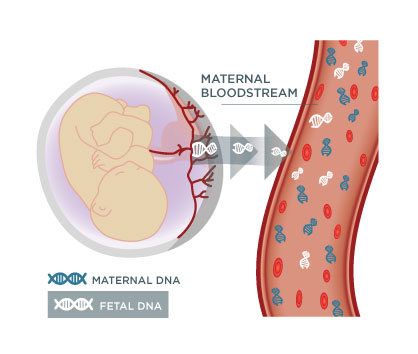Prenatal screening tests
(examples: NIPT (non-invasive prenatal testing), such as the Harmony test, ultrasound, first trimester screening)
Prenatal screening tests are designed to provide information that may reflect the health of your baby. Women may elect a screening test during pregnancy because they are hoping for reassurance but would also want to know if significant health issue in the pregnancy is suspected. Understanding the screening options can allow you to make an informed decision about which test is best for you. Your obstetric caregiver can provide additional information about your testing options.
Prenatal screening tests:
- Evaluate the chance for certain conditions in a pregnancy
- Pose no risk to the pregnancy
- Are followed by additional testing if a diagnosis is desired
- Performed as early as 10 weeks of pregnancy
- May indicate an increased chance for a condition in an unaffected pregnancy (“false positive”) or a low chance for a condition in an affected pregnancy (“false negative”)
Available prenatal screening tests1
The Harmony test using cell-free DNA
- Looks at fragments of your baby’s DNA in your blood
- Can be done as early as 10 weeks of pregnancy
- Screens for trisomy 21 (Down syndrome), trisomy 18 and trisomy 13
- High detection rates (> 99% detection rate for Down syndrome)2
- Low false positive rates (less than 1 in 1000 for trisomy 21, trisomy 18 and trisomy 13)2

Nuchal Translucency Ultrasound
- Ultrasound to measure the size of an area behind the baby’s neck called the nuchal translucency (NT)
- Done between 11-14 weeks of pregnancy by a certified practitioner
- Typically used in combination with blood tests to screen for chromosomal conditions1
- Can identify some major birth defects, but cannot rule out the presence of birth defects
- Does not replace a second trimester ultrasound evaluation
Traditional first trimester screening using ultrasound and blood draw
- NT ultrasound combined with blood marker analysis
- Performed in 9-14 weeks (blood test) and 11-14 weeks (NT ultrasound)
- 1 in 20 women receive a false positive result1
- Results from 5 days to 3 weeks depending on the time of blood draw and NT ultrasound
Prenatal Diagnostic tests
(Amniocentesis, CVS (Chorionic Villus Sampling))
Diagnostic tests are able to provide the most accurate information regarding the presence or absence of chromosomal conditions in a pregnancy, but they can lead to pregnancy loss. Some women elect a diagnostic test instead of a screening test, while other women choose to use the results of a screening test to decide whether or not to have a diagnostic test. Your doctor can provide additional information about your options and talk with you about what’s right for your pregnancy.
Diagnostic tests:
- Can diagnose and/or rule out certain conditions in pregnancy
- More definitive and comprehensive than prenatal screening tests
- Invasive and pose a risk of pregnancy loss
- Performed at 10-13 weeks (CVS) or 15-20 weeks (amniocentesis) of gestation
- Cannot detect or rule out all genetic or chromosomal conditions
Available prenatal diagnostics tests1
Amniocentesis
- Amniotic fluid around the fetus is collected using a needle
- Baby’s chromosomes from the cells in the fluid are studied in a lab
- Done between 15-20 weeks of pregnancy
- Risk of procedure-related miscarriage about 1 in 160 to 1 in 9003,4
Amniocentesis
- Amniotic fluid around the fetus is collected using a needle
- Baby’s chromosomes from the cells in the fluid are studied in a lab
- Done between 15-20 weeks of pregnancy
- Risk of procedure-related miscarriage about 1 in 160 to 1 in 9003,4
References
- ACOG Committee on Practice Bulletin No. 163. Obstet Gynecol. 2016 May;127(5):e123-37
- Stokowski et al. Prenatal Diagn. 2015; 35:1243-1246
- Mujezinovic et al. Obstet Gynecol. 2007;110(3):687.
- Akolekar et al. Ultrasound Obstet Gynecol 2015; 45:16-26.
